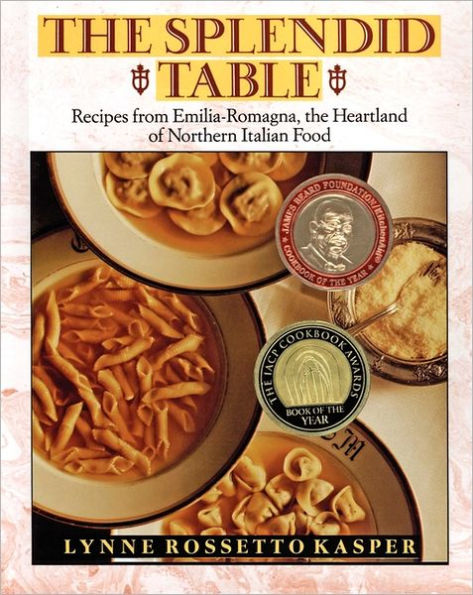Read an Excerpt
Romagna Grilled Veal Chops
Costolette in Graticola
Serves 4Grilled veal is the simplest and most satisfying kind of food The irresistible aroma of meats grilling over a wood fire greets you in many Romagna restaurants, especially those in the bills near Verucchio. There, Ristorante Zanni has an old waist-higb hearth as its grill Chops Of veal, pork, and the local castrato lamb turn brown and crusty over the hot coals while the fire warms the whole dining room. Make these chops as at Zanni, with either sage or rosemary. The recipe doubles easily.
4 veal loin or rib chops, cut 1 inch thick (about 13/4 pounds)
2 large cloves garlic, split
18 fresh sage leaves, or 4 or 5 sprigs fresh rosemary
3 tablespoons extra-virgin olive oil Generous pinch of black pepper
Salt to taste
Fresh sage or rosemary sprigs for garnish (optional)
Method
Working Ahead: The veal is best flavored with the garlic, herbs, and oil about 24 hours ahead. Keep it covered in the refrigerator. Serve the veal hot from the grill or stove-top.
Flavoring the Veal: Trim the chops of excess fat. Cut three shallow notches into the outer edge of the meat of each chop to keep it from curling in cooking. Place the chops in a shallow dish that holds them comfortably. Rub all the meat's surfaces with the split cloves of garlic. Then crush and rub the sage or rosemary into the meat, on all sides. Sprinkle the chops with the oil and pepper, slathering the oil over the meat. Tuck the garlic pieces and herb leaves among the chops, cover with plastic wrap, and refrigerateabout 24 hours.
Cooking the Veal: Cook the chops over a charcoal grill, preferably using real wood charcoal, or use a stove-top grill or a saute pan. Discard the garlic pieces before grilling.
Grilling over Charcoal: Heat the charcoal until a gray ash forms. Set the grin about 4 inches from the coals. Lift the chops from their dish, keeping the herbs on them, and set them on the hot grill. Quickly brown on both sides, lightly salting the chops before turning. Then slow down the cooking by covering the grill or by raising the rack several inches away from the fire. Cook a total of 10 minutes (including browning time), or until the chops are almost firm when pressed with the finger. If you have any doubt about doneness, make a small slit into the meat; it should be faintly blushed with pink,
Stove-top Grilling: Heat a gridded skillet or stove-top grill over medium-high heat. Brush the grill lightly with olive oil. Lift the chops from their dish, keeping the herbs on them. Take 2 to 4 minutes to quickly brown them on both sides, lightly salting the chops before turning, Immediately turn the heat to low and cook the chops 3 minutes per side, or until they are almost firm when pressed with a finger. Make sure the herbs are getting crisp without burning. If you have any doubt about doneness, check by making a small slit in the meat. It should be faintly blushed with pink.
"Grilling" in a Sauté Pan: Film the bottom of a 12-inch sauté pan with a little olive oil. Heat it over medium-high heat. Lift the veal chops from their dish, keeping the herbs on them. Take 2 to 3 minutes to quickly brown the chops on both sides, lightly salting them before turning. Lower the heat to low, and cook the chops about 3 minutes to a side, or until slightly firm when pressed. They should be faintly blushed with pink inside. Make sure the herbs are crisped but not burned.
Serving: Remove the chops to a platter and serve immediately. Garnish them with the grilled bits of herbs, and sprigs of fresh herbs if desired.
Suggestions Wine: A young, medium-bodied red Sangiovese di Romagna or a soft red Barbera d'Alba or d'Asti from the Piedmont.
Menu: Have the chops as part of a traditional Romagna country dinner. Begin with a few slices of good salami (page 501) and Piadina flatbread (page 384). Have more Piadina with the veal chops and Oven-Roasted Potatoes (page 344), Garlic-Sautéed Cabbage (page 331), or Salad of Mixed Greens and Fennel (page 349). Enjoy Nonna's Jam Tart (page 413) or Sweet Cornmeal Biscuits (page 422) with fresh fruit for dessert. A traditional pasta course is small portions of tagliatelle with Country-Style Ragù (page 48).
Cook's Notes Using Lamb or Pork: Use loin or rib chops-, cut 3/4 to 1 inch thick. Flavor and grill exactly as described above. Rosemary tends to be traditional with lamb, while either herb often flavors pork.
A Baked Pie of Polenta and Country Ragù
Polenta Pasticciata
Serves 6 to 8 Layering slices of polenta with meat ragù and Parmigiano-Reggiano cheese creates a lasagne-style casserole that is family food throughout Emilia-Romagna. The dish is ultimately practical, needing almost no last-minute effort. The polenta and ragù are best made ahead, and the assembled pie can wait a day before baking.
1 recipe Country-Style Ragù (page 48)
Olive oil
1 recipe Polenta (page 352), cooled in two oiled loaf pans
1 cup (4 ounces) freshly grated Italian Parmigiano-Reggiano cheese
Method Working Ahead: The polenta should be made at least 3 hours ahead so that it can be cool enough for slicing. It will keep, covered and refrigerated, 1 day. The ragù can be made and frozen up to a month in advance. The assembled dish can be covered and refrigerated up to 24 hours before baking. Bring it close to room temperature before baking.
Assembling the Pie: Bring the ragù close to room temperature. Use olive oil to grease the bottom and sides of a shallow 3-quart baking dish. Cut the polenta into 1/4- to 1/2-inch-thick slices. Spread a few spoonfuls of ragù over the bottom of the baking dish. Then entirely cover the bottom of the dish with a single layer of polenta slices. Spread half the ragù over the polenta, and sprinkle with 1/4 cup of the cheese.
Add another layer of polenta, covering the ragù completely. Top with the rest of the ragù and another 1/4 cup of the cheese. Finish the casserole with a final layer of polenta slices to cover the ragù. (There may be a few slices left over.) Spread about 1 tablespoon olive oil over the polenta, and then sprinkle with the remaining 112 cup Parmigiano-Reggiano. Cover the casserole with foil. Refrigerate if working ahead.
Baking and Serving: Preheat the oven to 350 °F. The pie should be close to room temperature. Set it on a baking sheet. Bake for 1 to 1 1/2 hours, covered, or until a knife inserted in the center of the casserole and left there about 30 seconds comes out quite warm. Once the casserole is heated through, uncover and bake another 5 minutes. The cheese topping should be melted but not leathery or dark brown. Cut the pie into squares, and serve on warmed dinner plates.
Suggestions Wine: A generous, quaffable red like a fine Sangiovese di Romagna, a Barbarossa from Bertinoro, Tuscany's Rosso di Montalcino, a young fruity Chianti Montalbano, or a young Rossese di Dolceacqua from Liguria.
Menu: The pie is a one-dish meal, needing only a light antipasto, a salad, and dessert. Begin with small portions of Grilled Winter Endives (page 337), or a few slices of coppa (page 474) served with Marinated Baby Onions (page 16). Have the Salad of Mixed Greens and Fennel (page 349) with the pie or after it, then dessert of Ugo Falavigna's Apple Cream Tart (page 411) or Caramelized Almond Tart (page 409).
Cook's Notes Variations: For polenta casseroles with a variety of fillings, including meatless ones, see the main polenta recipe on page 352.



